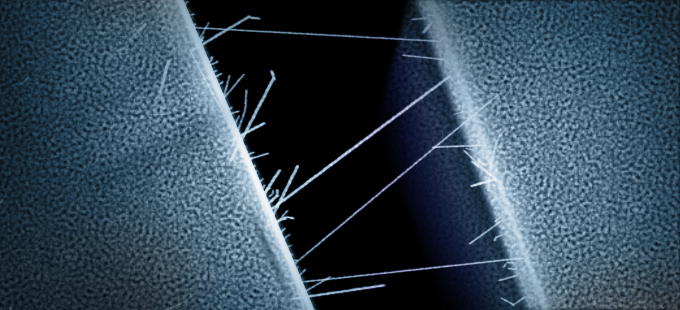Tin Whiskers in equipment
or the advantage of lead containing solder
I spotted this issue first time, while researching about detoriation of RF Germanium Transistors. Then, in my 1955 Hammond Organ, there is a ultra fine layer of white powder on many of the plated items. I have not investigated what that is, but I HOPE it is zinc plating oxide, as Zinc is not poisonous, even so the human body needs 50mg or so per day. However the body does not need Cadmium or Tin, so I hope that is not what that is! To be sure, I clean some of the parts outside in the wind. It brushes off like dust. Then again by trying to find out what it is, I stumbled across the "tin whiskers" item in the internet. So I looked a bit deeper into this, and results are interesting.
What are Tin whiskers? Good Question. These are very thin hairs of Tin, growing from tin plated surfaces. There are other kind of whiskers too, like Silver (sulfide) Whiskers, or dendrites, but this here is about TIN WHISKERS. These have probably been around ever since tin was molded by men, but we discovered it not before 1940. The solution was found quickly: Add enough Lead to the Tin solder, and the problem is gone. Lead is a strange metal. It makes many things better. Like car petrol, and solder, and it is a great battery element since the "Electron Volt" number is high. It is heavy, so nice to make weights, and it is weather proof. Lead oxide is a very stabile and cheap white colorant, and rust preventing. Great for ships and cars. Even so the orange lead oxide was the best, it was so poisonous it would even kill bacteria. Wood repairs on windows were done with that orange kit, when I was a young boy, and we used to scrape it out, when the painter was gone, and make balls of it, to play with. Even in cigarette smoke there is a lot. Yes, you can do many things with lead, because it is cheap, and a great material. It stayed like that, until even the greatest liars could not deny any more it is also poisonous. I think that was around 1960 for drinking water pipes, around 1965 for lead containing paint, around 1980 for lead containing gasoline, around 2010 for lead containing solder. I think around 2035 lead containing car batteries will be the next discovery, as car batteries so far were no issue. So that 100 gram lead containing solder is removed from your car, but that 10kilogram chunk of lead is still there, called: Starter Battery. And no, this is not the only way to make a car battery. It is just the cheapest way, as with all the other examples too.
Anyway, the trend is away from lead. So we are getting back to the whisker problems again. Yet it was never a fully unknown problem. Perhaps you wondered why some of the 1960's expensive IC's and transistors had gold plated caps and wires. Well... how about whiskers!

This is a microscope picture, demonstrating how fine these metal hairs can be. I have lots of old stuff and parts here, but I must say, so far I found none yet myself.

Tin plated wire wrap connector, full of whiskers.

This is a bit more practical example. I found in other web pages, that the voltage across a whisker usually blows them away, but here you see a resonator circuit, and due to the low voltage the whisker will stay. Note the clean environment, and that didn't stop it from growing.
What causes whiskers? Believe it or not, but this is unknown how or why they grow. A few things we do know, but it is not much.
- They grow on pure tin surface and they grow very slow. They do not grow on lead-tin alloy. So ROHS conforming electronics have a HUGE hidden problem for the future.
- You can see them often on tin plated iron.
- Environmental dirt plays no role, as they are often found inside transistor cases, that are very clean inside and airtight sealed. Some very dirty parts do not necessarily have them.
- They grow better on surfaces with some form of mechanical tension. Like all mechanical parts that are made from tin plated iron, as tin and iron have another expansion coefficient. Also a solder joints develop tension when cooling down. The above picture is a die cast, not bended, but the whisker is just there where you have the mechanical force of the screw. So that sort of feeds the assumption.